Introduction
Distributed ledgers have consolidated as one of the most disruptive applications of information technology that have appeared in recent years. They can store any kind of data as a consensus-based repository of replicated, shared, and synchronized digital records distributed across multiple sites, without depending on any central administrator. Their properties regarding immutability, traceability, managed repudiation, and multi-party verifiability opens an opportunity for a wide range of applications, and new interaction models among those entities using such ledgers.
These technologies have become the intrinsic foundation of secure decentralized transaction-based applications, including (but not limited to) decentralized cryptocurrencies. They are often referred to as blockchain, given the use of cryptographic techniques to link a growing list of blocks (records). While blockchain is a specific implementation of a distributed ledger, the industry has conformed with use of a more generic term: DLT (Distributed Ledger Technology). The conformance with the above features is one of the core components of these ledgers. Some of the additional capabilities of DLTs is support of smart contracts, support to digital identity attributes, object tracking, and the verification of service level agreements.
Distributed ledgers can be considered as permissioned or permission-less, referring to the requirements for a node to be approved to validate transactions and record them on the ledger. While permission-less ledgers are the ones that have received most attention from the public (with the paradigmatic example of Bitcoin), permissioned distributed ledgers (also known as PDL) are the better qualified to address most of the use cases of interest to industrial and governmental institutions. The reasons are related to both technical and legal aspects. Attributes including the cost and maximal frequency of recording of a transaction, the cost of the consensus algorithm, and the fairness properties among participants are where PDLs are advantageous compared with non-permissioned DLTs. Enforcement of external legal agreements using Smart Contracts addresses regulatory enforcement in critical sectors.
The ETSI Industry Specification Group on Permissioned Distributed Ledger (ISG PDL) analyses and provides the foundations for the operation of permissioned distributed ledgers, with the ultimate purpose of creating an open ecosystem of industrial solutions to be deployed by different sectors, fostering the application of these technologies, and therefore contributing to consolidate the trust and dependability on information technologies supported by global, open telecommunications networks. The group puts its focus on addressing ICT infrastructure and operational aspects that are not currently covered by previous or parallel standardization activities. In addition to that ISG PDL fosters industry convergence towards shared standards with the intent of avoiding duplication and contradicting publications.
Our Roles & Activities
The ISG PDL started from already available experiences in the field of permissioned distributed ledgers, seeking for the definition of open and well-known operational mechanisms to validate participant nodes, support the automation of the lifecycles of the ledger and individual nodes, publish and execute operations regarding the recorded transactions through smart contracts, improve security of ledgers during both their design and operation and establish trusted links among different ledgers using these mechanisms.
ISG PDL has been active since 2019 and has produced the following completed deliverables to date. The PDF deliverables may be downloaded from the links:
- PDL-001 - Landscape of Standards and Technologies
- PDL-002 - Applicability and Compliance to Data Processing Requirements
- PDL-003 - Application Scenarios
- PDL-004 - Smart Contracts PDL System Architecture and Functional Specification
- PDL-005 - Proof of Concepts Framework
- PDL-006 - Inter-Ledger interoperability
- PDL-008 - Research and Innovation Landscape
- PDL-009 - Federated Data Management
- PDL-010 - Operations in Offline Mode
- PDL-011 - Specification of Requirements for Smart Contracts' architecture and security (revision 2)
- PDL-012 - Reference Architecture
- PDL-013 - Supporting Distributed Data Management
- PDL-014 - Study on non-repudiation techniques
- PDL-015 - Reputation Management
- PDL 017 - Application of PDL to Amended Regulation 910/2014 (eIDAS 2) Qualified Trust Services
- PDL-018 - Redactable Distributed Ledgers
- PDL-019 - PDL Services for Identity and Trust Management
- PDL-020 - Wireless Consensus Network
- PDL-021 - 3GPP use cases
- PDL-022 - PDL use in supply chain management
- PDL-023 - PDL service enablers for Decentralized Identification and Trust Management
- PDL-024 - Architecture enhancements for PDL service provisioning in telecom networks
- PDL-026 - Settlement of usage-based services
Additional work is in progress including the following drafts, link to the ETSI WP database public view:
- PDL-016 - Oracles for Smart Contracts (idle pending the Data Act)
- PDL-025 - Wireless Consensus Specifications (stable draft)
- PDL-027 - Self Sovereign Identity in Telecom Networks (stable draft)
- PDL-028 - Utilizing PDL in oneM2M standardized IoT service layer platform (stable draft)
- PDL-029 - Distributed Autonomous Organization (In Publication)
- PDL-030 - Trust in Telecom System (Final draft)
- PDL-031 - Energy Consumption Data Sharing based on PDL Service (early draft)
- PDL-032 - AI for Secure and Scalable PDL (ISG Approved)
- PDL-033 - Combining PDL-004 and 011 Smart Contracts (Stable draft)
- PDL-034 - Trustworthy Data Space Infrastructure with PDL (no draft yet)
ISG PDL has defined a PDL Reference Architecture in PDL-003 and PDL-012 as depicted in the diagram below.
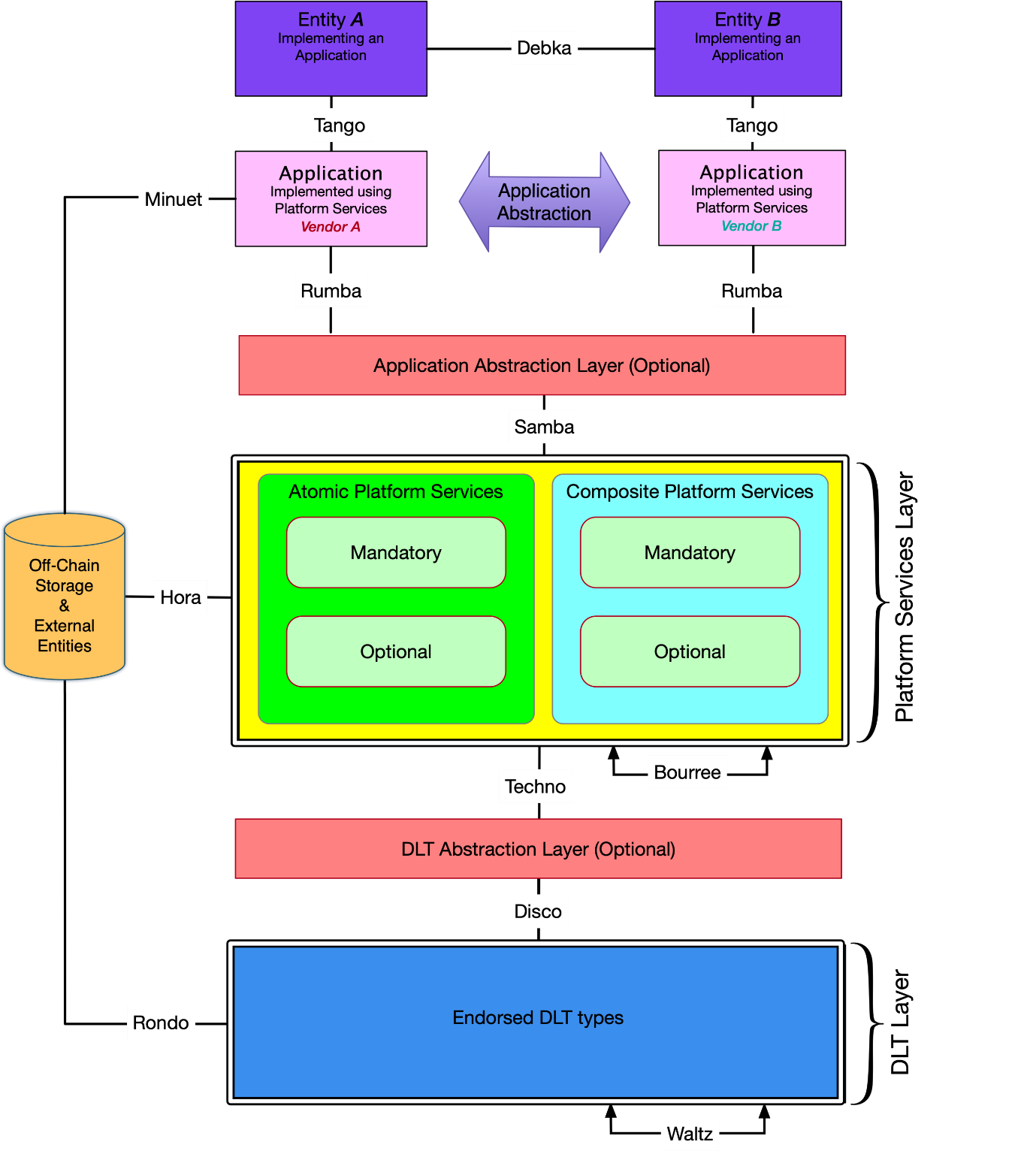
PDL-009 and PDL-013 discuss the application to federated and distributed data management of the PDL reference architecture, including architectural requirements derived from distributed data management use cases, and the definition of extended ETSI ISG-PDL platform services for PDL-based distributed data management.
Examples of which are presented in the below diagram.
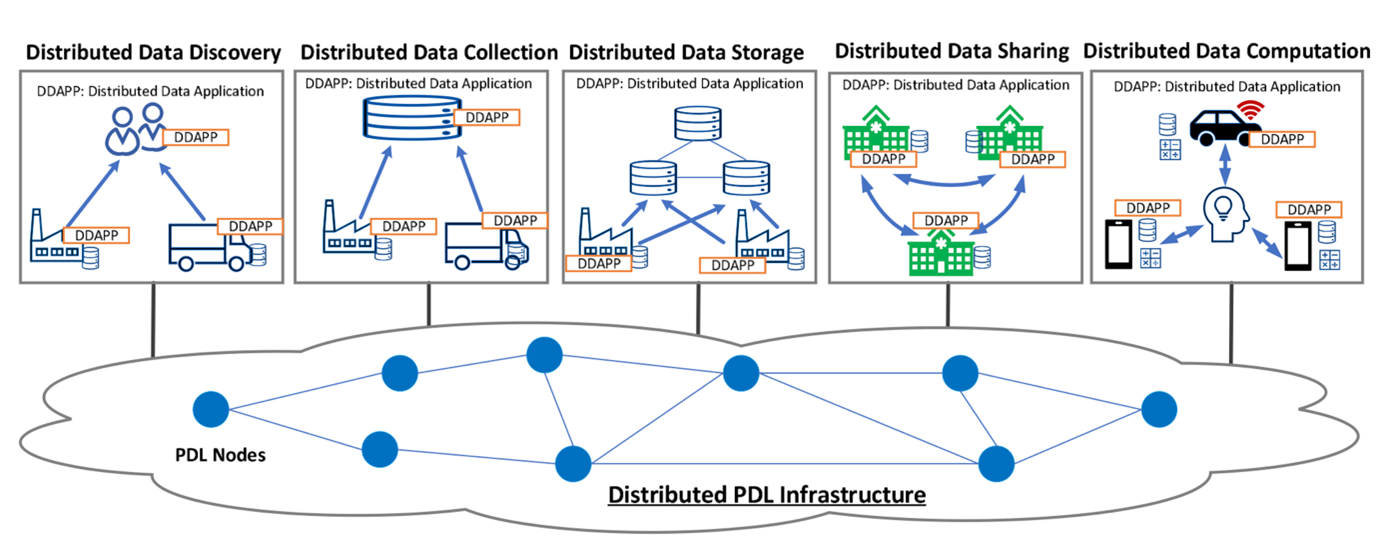
PDL-010 provides an analysis of the challenges related to data storage and ledger operations when a single PDL node or several PDL nodes are offline, including procedures and architecture design to address these challenges.
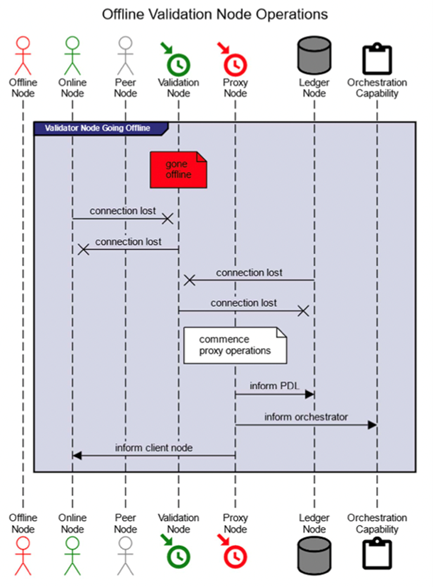
Smart contracts and their functionality is introduced and defined in PDL-004, and their planning, coding, requirements, EU Commission discussion, and testing are discussed in PDL-011 version 2.1.1. This information is revised and combined in PDL-033, that will be published soon. The Work relating to EIDAS is progressing in close cooperation with TC ESI PDL 017. The relation to Smart contract oracles and The EU Data act PDL-016 was put on hold as the EU parliament requirement elapsed it is expected to be restarted under TC Data.
Significant efforts are made to address key issues such as interoperability PDL-006, immutability PDL-014, redaction PDL-018, reputation PDL-015, as well as specific implementations including wireless networks PDL-021 & PDL‑024 and supply chain management PDL-022 & PDL-026.
The specific architectural requirements for telecom networks to enable offering PDL/Blockchain-as-a-Service (PDLaaS) are discussed in PDL-024. This document defines the required functions, interface and interactions between the PDL-specific functionality and existing telecom network functionalities.
Recent work includes architectural support for non-repudiation of input and output data for a PDL, reputation management, methods for managed redactability of PDL data, identity, and trust management as demonstrated in PDL-023 and specified in PDL-018 (revised) on redaction and PDL-030 on identity.
As wireless networks become an integral part of PDL implementations, PDL-020 and PDL-025 discuss and specify wireless consensus in critical Wireless IoT automation, and PDL-021 investigates 3GPP use cases and network specification in PDL-027.
Some recent work is focused on the ICT and telecom carrier environment. That includes PDL-022 that discusses PDL in supply chain management, PDL-026 that discusses use of PDL for settlement of usage-based services and PDL-027 that discusses PDL Self Sovereign Identity for service providers.
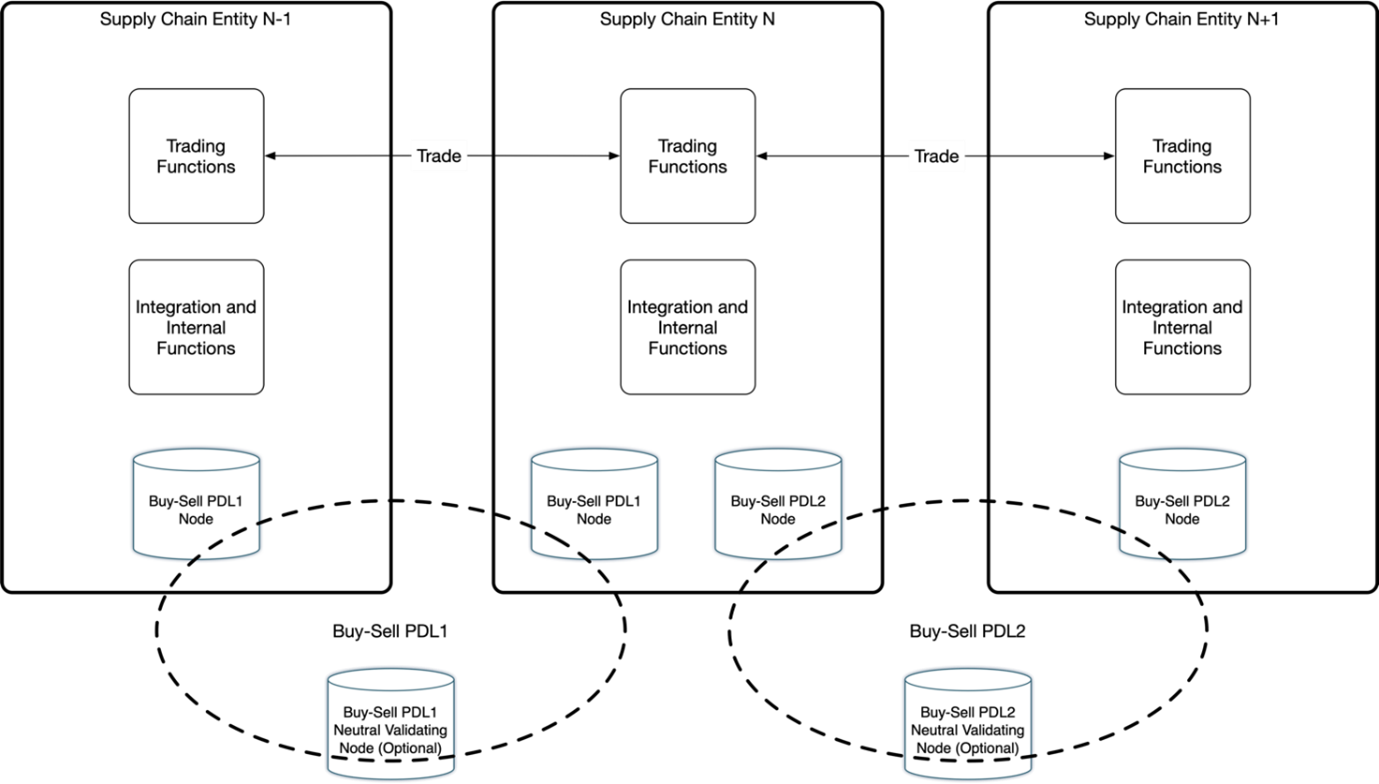
In addition to written deliverables a framework for technology assessment and demonstration via proofs of concept has been established. The ISG has established a strong connection with research activities, especially the collaborative research projects within the Horizon 2020 programme and has concluded three successful PoCs to date.
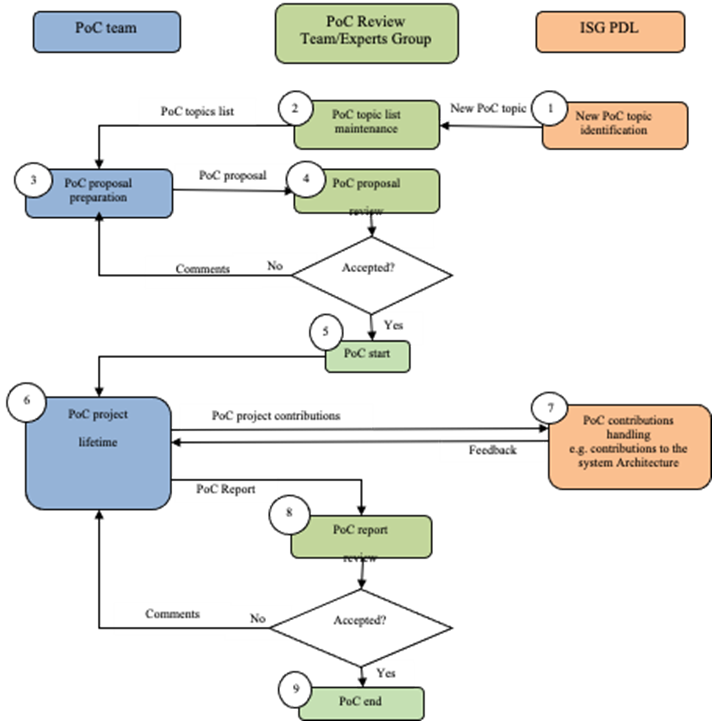
The community continues working on additional topics of interest, such as Supply Chain Management, and further study of projects related to software and network related aspects such as 3GPP standards, Wireless networks, Smart contracts as well as collaboration with other European institutions such as eIDAS and CEN/CENELEC. ISG PDL plans to explore new application environments, especially those enabled by the emergence of next-generation networking infrastructures. Those include IoT, Mobility, Edge, Tokenization, resource trading at all levels, as well as new industrial scenarios. DAOs (Digital Autonomous Organisations) are emerging as an effective solution to governance in a distributed, multi-party, environment and ISG PDL‑029 is exploring this topic.
Specifications
The ISG PDL works in tight coordination with other groups in ETSI and elsewhere, including open-source initiatives and ISG PDL is committed to produce deliverables of three different natures: informative (studies and recommendations for further work), normative (specifications) and demonstrative (in the form of proof‑of‑concept reports and interoperability assessment events).
The ETSI PDL Reference architecture PDL-012 is aligned with the GSMA and CBAN reference architectures. Furthermore, recent work PDL-028 explores the use of PDL in oneM2M IoT standards.
A full list of related specifications in the public domain is accessible via the ISG PDL committee page, and can be searched through the ETSI web search interface. ISG PDL documentation is open for public access to facilitate interaction with research and industry. Early versions of working drafts are publicly available at the document open area.
